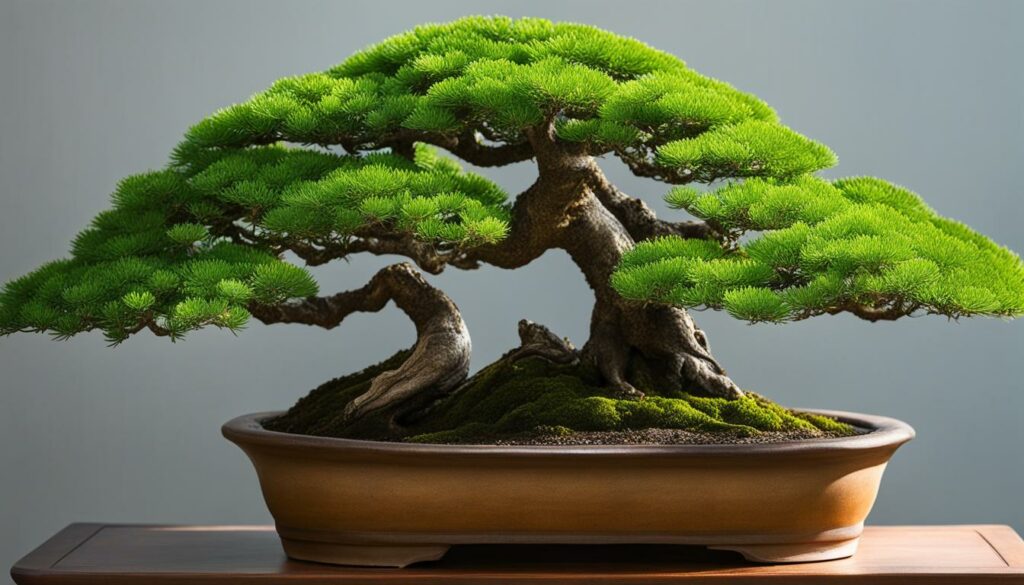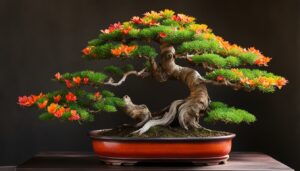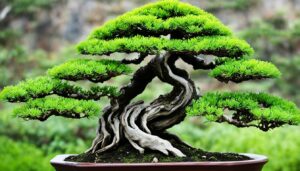You love bonsai. Creating miniature trees that are both beautiful and healthy is a true art form. Bonsai styling is a delicate balance between aesthetics and the health of the tree. When creating a bonsai masterpiece, it is important to consider both the tree’s well-being and the beauty of the design.
In this article, we will explore the art of bonsai styling and how to create stunning designs while prioritizing the health of your miniature trees. We will discuss the importance of tree wellness, sustainable styling practices, and creating ideal bonsai environments. If you are passionate about bonsai, read on to discover how to create stunning bonsai designs that are also healthy and thriving.
Key Takeaways:
- Bonsai styling is a balance between aesthetics and the health of the tree.
- Prioritizing tree wellness is essential for the longevity and quality of the bonsai.
- Choosing the right species and techniques promote both health and visual appeal.
- Sustainable bonsai styling practices contribute to the long-term vitality of the trees.
- An optimal bonsai environment involves proper lighting, temperature, humidity, and air circulation.
Understanding Bonsai Styling
Bonsai styling is an art form that involves shaping and pruning trees into miniature, aesthetically pleasing shapes. It originated in China several centuries ago and has since been adopted and adapted by cultures worldwide. At its core, bonsai is a harmonious blend of art and horticulture, requiring meticulous care to achieve the desired results.
The principles of bonsai styling involve creating trees that mimic the shapes of their larger counterparts found in nature. By controlling the growth of the tree, bonsai artists can manipulate the shape, size, and appearance of the tree’s foliage and branches, resulting in unique, stunning creations.
The process of bonsai styling requires a deep understanding of the tree’s biology and growth patterns. This knowledge is fundamental to ensuring that the tree is not only visually appealing but also healthy and sustainable. With proper care and attention, bonsai trees can live for decades, providing a lifetime of enjoyment and beauty.
In the upcoming sections, we will dive deeper into the techniques and considerations that are essential to creating beautiful, healthy bonsai trees. We will explore the balance between aesthetics and health, the importance of proper tree wellness, and sustainable styling practices that support the longevity of these living works of art.
The Importance of Health in Bonsai Styling
When it comes to bonsai styling, it’s essential to prioritize the health of the tree. Neglecting tree health can have significant consequences on the overall quality and longevity of your bonsai masterpiece. While you may be focused on creating a visually appealing design, it’s crucial to remember that the tree’s health should always be the number one priority.
Keeping the tree healthy means understanding its basic needs and taking care of them. Proper watering, fertilization, pruning, and disease prevention are all crucial components of bonsai tree wellness. Each of these considerations directly affects the health and growth of the tree, enabling it to thrive and become a beautiful bonsai masterpiece.
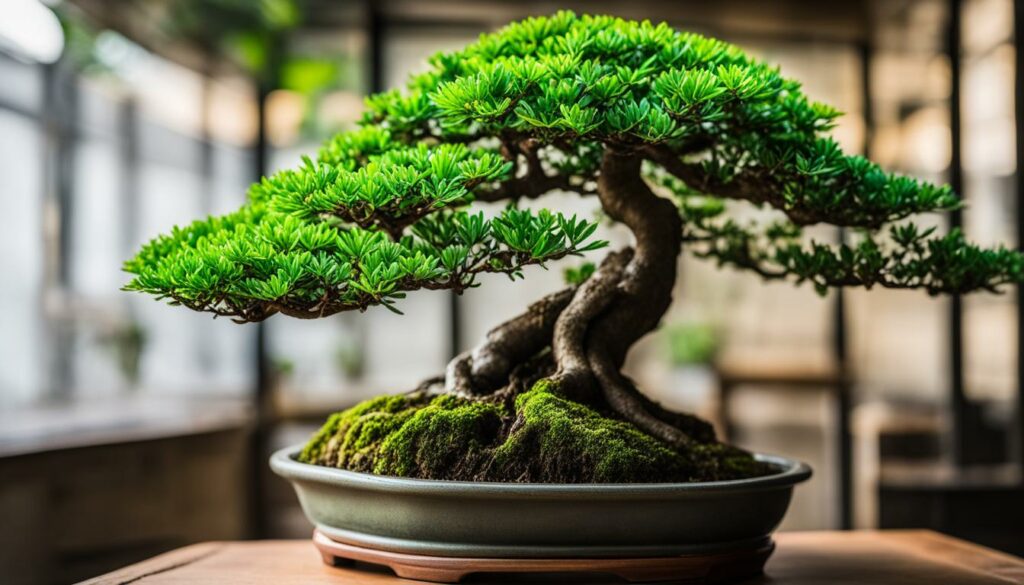
If you neglect to take proper care of your bonsai tree, it can develop diseases and die. While some may be tempted to overlook health considerations in favor of aesthetics, the result can be a short-lived and disappointing display. You put in so much effort in styling your bonsai, so why not ensure that it can last and thrive?
In addition to the well-being of your bonsai tree, neglecting its health can also pose a risk to your own health. An unhealthy tree can harbor pests and diseases, potentially putting you and other plants in your home or garden at risk.
Overall, when styling your bonsai, considering its health is crucial. By prioritizing the tree’s wellness, you not only ensure the longevity and beauty of your bonsai but also create a healthy environment for you and your other plants to thrive.
Finding the Balance: Aesthetics and Health
When styling a bonsai, it’s essential to strike the right balance between aesthetics and the health of the tree. While creating visually appealing designs is undoubtedly a top priority, it’s equally crucial to focus on the well-being of your miniature tree. Paying attention to both elements will not only result in a stunning bonsai but also ensure its longevity and vitality.
The key to achieving this balance is through sustainable styling practices. This involves using techniques and products that promote ecological and environmental responsibility. It’s essential to consider the materials you use, such as wires, fertilizers, and tools, as these can ultimately affect the life of your bonsai. One good practice to consider is reducing the use of synthetic products and opt for natural or organic ones. These products, such as organic fertilizers, provide the needed nutrients without harming the soil or surrounding ecosystem.
Balancing Design and Health in Bonsai Styling
When designing a bonsai, consider the following principles to ensure a healthy tree:
- Balance: A well-proportioned bonsai won’t be a burden to the root system or the overall growth of the tree. A balanced tree maintains its health by receiving proper nutrition and sunlight.
- Mobility: Avoid overwatering your bonsai or leaving it on a tray of water, which can lead to inadequate drainage and oxygen levels. This limits its mobility, causing stunted growth and nutrient deficiencies.
- Simplicity: At times, less is more. Overcomplicated designs with too many branches or visual elements can cause stress on the tree and limit its survival.
By using sustainable styling practices and considering the bonsai style and tree health, you can create a masterpiece that looks gorgeous and lives a long life.
Understanding Tree Wellness
Creating and maintaining a healthy bonsai tree is essential for longevity and aesthetics. To ensure the well-being of your bonsai, you must become familiar with tree wellness measures that include proper watering, nutrition, pruning, and disease prevention.
One of the critical aspects of tree wellness in bonsai is proper watering. A bonsai’s water requirements vary depending on the season and climate. You should check the soil moisture level frequently and avoid overwatering or underwatering.
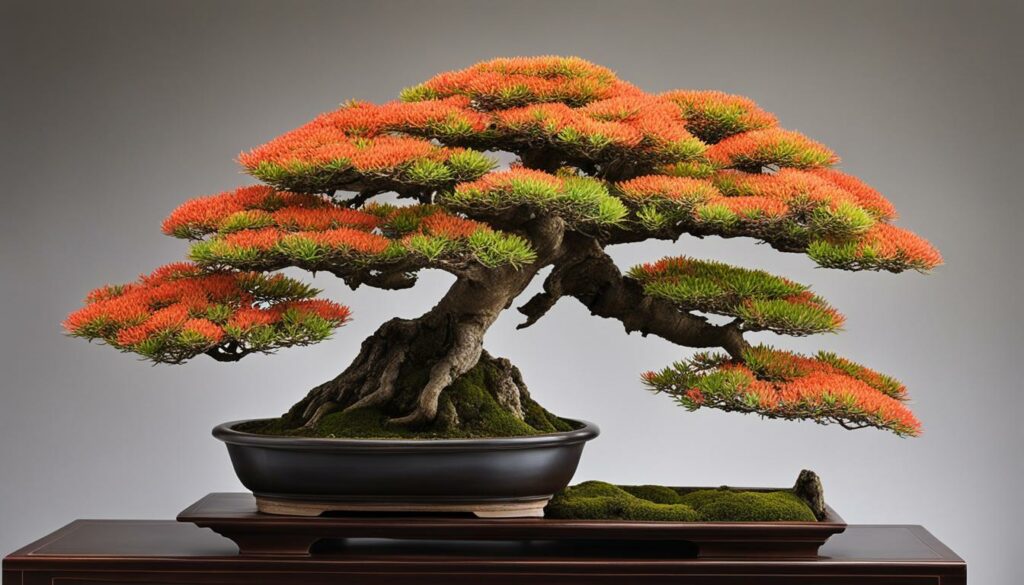
Another vital aspect of tree wellness is providing adequate nutrition through fertilization. Bonsai trees need a balanced fertilizer with the right amount of nitrogen, phosphorus, and potassium. You should fertilize your bonsai during the growing season, following proper dosages to avoid burning the roots.
To keep your bonsai healthy and aesthetically pleasing, you must also undertake pruning practices regularly. Pruning helps stimulate growth and prevents overcrowding, leading to a more structured and healthy tree. You should remove dead, damaged, and overgrown branches and buds, especially during the growing season.
Lastly, disease prevention is critical to ensure the long-term wellness of your bonsai tree. You can prevent diseases by keeping the soil moist and well-draining, allowing proper airflow, and avoiding direct sunlight, which can scorch the leaves. If you suspect your bonsai has a disease or pest problem, you should take proactive measures immediately to prevent spreading the infection.
Tree Wellness Checklist:
| Wellness Measures | Frequency |
|---|---|
| Proper Watering | Check soil moisture daily and water when needed. |
| Fertilization | Fertilize during the growing season, following proper dosage instructions. |
| Pruning | Prune regularly to remove dead, damaged, or overgrown branches and buds. |
| Disease Prevention | Keep soil moist and well-draining. Allow proper airflow and avoid direct sunlight. Take proactive measures if you suspect disease or pest problems. |
Choosing the Right Bonsai Species
When it comes to achieving a balance between aesthetics and health in bonsai styling, species selection plays a crucial role. Choosing the right species is paramount to creating a thriving, visually appealing bonsai design.
Each bonsai species has its unique requirements, such as light, temperature, humidity, and soil composition. Understanding the tree’s specific needs can help you make an informed decision when selecting a species for your desired bonsai design.
Factors to Consider in Bonsai Species Selection
| Factor | Description |
|---|---|
| Size | Consider the tree’s natural growth size and the size it can be reduced to using various styling techniques. |
| Leaf Size and Shape | Take into account the leaf size and shape as they significantly impact the visual appeal of the bonsai. |
| Branching Habit | The branching habit of the species influences the styling techniques that can be applied to the tree. |
| Bark Texture and Color | Consider the bark texture and color as they add to the beauty of the bonsai design. |
| Health Requirements | Ensure the species allows for the bonsai’s health requirements, including suitable soil, water, and light conditions. |
By considering the factors listed above and understanding each bonsai species’s unique needs, you can choose a species suitable for your desired styling technique and environment. This will ensure the long-term health and beauty of your bonsai design.
Styling Techniques for Health and Aesthetics
When styling bonsai, it is crucial to balance both aesthetics and health. Creating beautiful designs shouldn’t come at the expense of the tree’s well-being. There are a few techniques that you can employ to ensure that your bonsai looks stunning and remains in excellent health.
Wiring
Wiring is a technique that helps you shape your bonsai branches according to your vision. This technique involves wrapping aluminum wire around the branches and carefully bending them into the desired shape. It is important to do it gently and make sure the wire is not too tight to prevent damaging the tree bark. Using wire cutters, remove the wire after a few months once the branches have set in the desired shape.
Pruning
Pruning is an essential technique to keep your bonsai in good health. Removing damaged, dead or overgrown branches helps to direct the tree’s energy towards new growth. Use sharp scissors or pruning shears to make clean cuts at an angle, leaving a small amount of the branch to prevent damaging the tree. Avoid pruning too often or too much at once, as it can weaken the tree and make it vulnerable to diseases.
Shaping
Shaping is the process of forming the overall look of your bonsai. It involves choosing the right positioning, balancing root growth with foliage, and making precise cuts. It’s important to take your time and not rush this process to avoid causing damage to the tree. Keep in mind the bonsai’s natural growth patterns and strive to create a harmonious balance between branches, foliage, and roots.
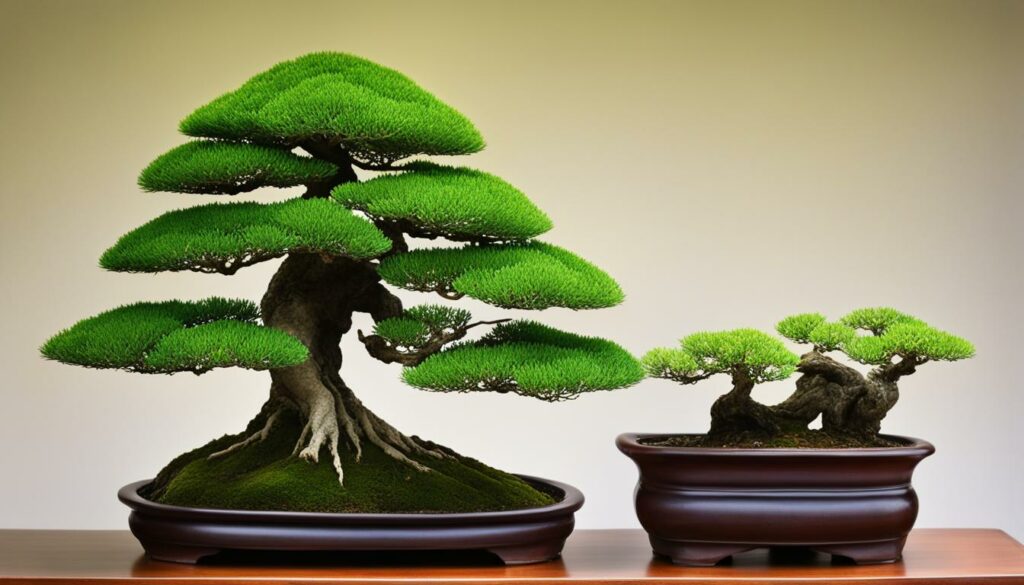
These styling techniques can help you achieve a bonsai design that is both visually stunning and healthy. By carefully wiring, pruning, and shaping your tree, you can create a beautiful masterpiece while giving your tree the care and attention it deserves.
The Role of Potting and Soil
Choosing the right potting and soil is essential in maintaining the health and beauty of your bonsai tree. Proper drainage, root development, and soil composition are all crucial factors to consider when it comes to the overall well-being of your miniature tree.
To ensure adequate drainage, it is essential to choose a pot with sufficient drainage holes. Do not use a pot without drainage holes as waterlogging can cause root rot and other tree diseases. Take note of the pot’s size as well; it must match the size of the tree and be proportionate to its overall style. A bonsai’s pot should complement its visual appeal and not overpower or underwhelm its beauty.
The soil composition is another crucial factor when it comes to bonsai health. The soil must provide adequate nutrients, oxygen, and moisture for the roots. Bonsai trees require a well-draining soil mix that typically consists of Akadama, Pumice, and Lava Rock. Finding the right balance between these soil components can help promote healthy root growth and overall tree health.
The right pot and soil are the foundation for maintaining a healthy and beautiful bonsai tree.
Training and Maintenance of Bonsai
Caring for your bonsai regularly is paramount to ensure that it remains healthy and visually appealing. The following techniques are essential for training and maintenance of bonsai:
- Re-potting: This is the process of switching a bonsai from its current pot to a new one with fresh soil. It is vital to prevent the roots from becoming pot-bound, which takes away their much-needed nutrients.
- Root pruning: This technique involves removing some parts of the root system from the bonsai to promote new root growth and reduce the size of the established roots, which encourages better soil moisture retention and nutrient absorption.
- Branch maintenance: Bonsai requires regular pruning to maintain the desired shape and style of the tree. Pruning also promotes better air circulation, exposing the leaves to enough sunlight and reducing the risk of disease.
Proper training and maintenance should be done cautiously to avoid harming the tree. Considerations such as the type of species, current health status, and styling goals should guide these techniques. Additionally, frequent monitoring of the bonsai to identify any leaf discoloration, pest infestations, or other signs of distress is essential. This ensures that prompt action can be taken to tackle any issues.
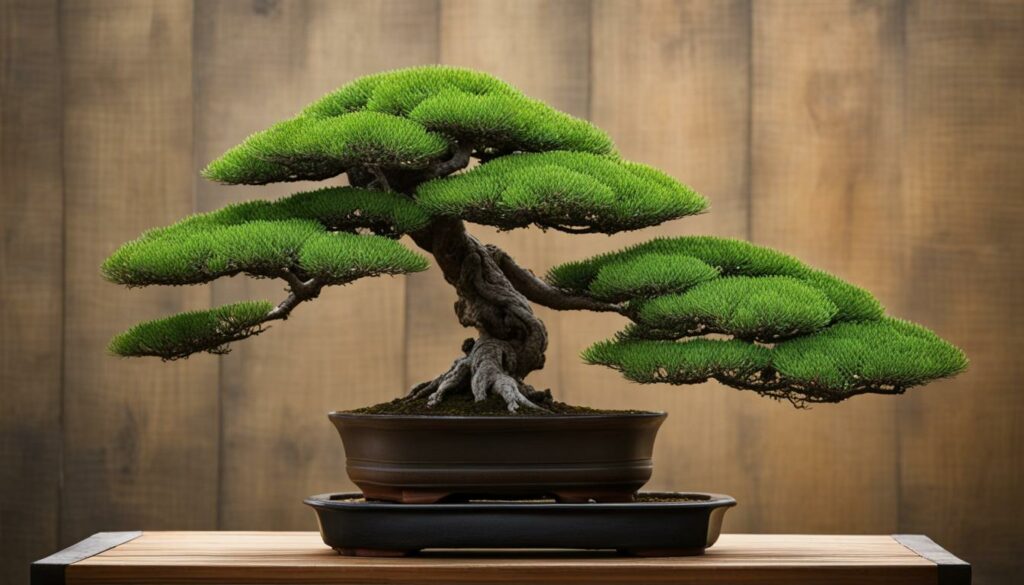
Sustainable Styling Practices
When creating beautiful bonsai designs, it’s vital to use sustainable styling practices to ensure the long-term health and vitality of your miniature trees. Organic fertilizers, such as those made from seaweed and fish emulsion, are excellent alternatives to chemical fertilizers. They provide essential nutrients to your bonsai without harming the environment.
Pest management is also a crucial aspect of sustainable bonsai styling. Integrated pest management techniques, such as the use of beneficial insects, can help control pests without harming other plants or animals in the ecosystem.
“Sustainable styling practices help create beautiful bonsai designs that have a positive impact on the environment.”
When selecting materials for your bonsai, consider environmentally friendly options such as reclaimed wood and natural products like bamboo for wiring. These materials are not only sustainable but also add an organic aesthetic to your designs.
By using sustainable styling practices, you can create beautiful bonsai designs that have a positive impact on the environment. It’s essential to remember that bonsai trees are not just decorative objects but living beings that require your care and attention to thrive.
Creating Thriving Bonsai Environments
Creating the ideal environment is crucial to balancing both aesthetics and the health of your bonsai. Factors such as light, temperature, humidity, and air circulation all play a significant role in the growth and development of your miniature tree.
The amount and type of light your bonsai receives can impact its overall health and appearance. Choose a location that receives adequate sunlight for your specific species of plant. Some bonsai trees thrive in direct sunlight, while others prefer partial shade to avoid scorching.
Temperature also plays an important role in your bonsai’s health. Keep in mind that bonsai pots can get much colder or hotter than in-ground plants, so you’ll need to monitor temperature fluctuations closely. Avoid extremes in temperature, which can cause undue stress to your plant.
Humidity is crucial to maintaining bonsai wellness. Dry environments can cause your tree to wither and die. Place a humidity tray under your bonsai or use a humidifier to keep the air moist enough for the bonsai’s needs.
Finally, proper air circulation is necessary to prevent disease and pest infiltration. Your bonsai needs fresh air to thrive. Avoid placing your plant in an area that is stagnant or has poor ventilation.
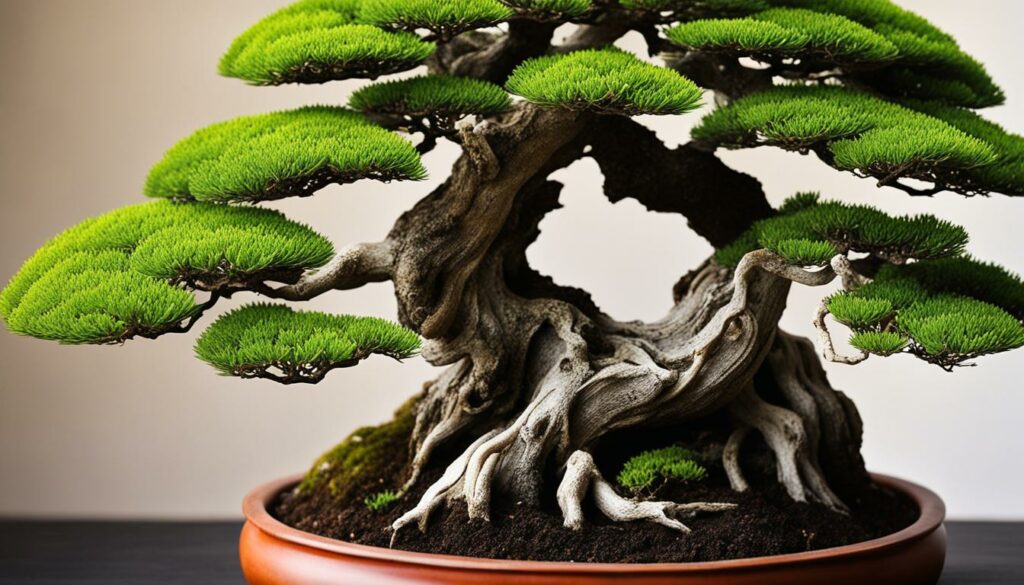
When creating the ideal environment for your bonsai, it’s essential to consider the perfect balance of sunlight, temperature, humidity, and air circulation. Doing so allows your bonsai to thrive both in health and beauty.
The Art of Bonsai Display
Displaying your bonsai masterpiece is an art in itself. It is an opportunity to showcase the balance between aesthetics and health that you have worked so hard to achieve. Proper positioning is essential for ensuring that your bonsai is viewed from its best angle. A background like a simple wall or backdrop can provide an effortless yet eye-catching setting.
Accessories such as bonsai stands, pots, and accent plants can complement your bonsai and enhance its beauty. But be careful not to overdo it. A cluttered display can detract from the simplicity and elegance of your bonsai.
“The minimalist aesthetic of bonsai should not be overshadowed with too many elements.”
To add depth to your display, consider arranging your bonsai in groups of two or three, creating a miniature forest effect. Varying the height and size of bonsai in the group adds dynamics to the scenery. Alternatively, you could showcase your bonsai in a tokonoma – a traditional alcove for displaying art in Japanese homes.
Key Takeaways
- Proper positioning is important in displaying your bonsai from its best angle.
- Simple backgrounds can help put the focus on the bonsai.
- Accessories such as stands and pots can enhance the beauty of your display, but be careful not to clutter.
- Consider arranging your bonsai in groups to create a miniature forest, or showcase your bonsai in a tokonoma.
The Importance of Balancing Aesthetics and Health in Bonsai Styling
As you have learned from this article, Bonsai Styling Balancing Aesthetics and Health is crucial for creating beautiful and long-lasting bonsai trees. Neglecting tree health can lead to stunted growth, disease, and ultimately, the demise of your beloved miniature tree.
When styling your bonsai, it is important to prioritize the well-being of the tree while achieving your desired aesthetics. This involves selecting the right species, using sustainable styling practices, and maintaining optimal growing conditions.
By choosing species that are suitable for your desired bonsai design and can thrive in your environment, you will be able to create visually stunning trees that are also healthy and resilient.
Using sustainable bonsai styling practices, such as organic fertilizers, pest management, and environmentally friendly techniques, will contribute to the long-term health and vitality of your bonsai.
To ensure that your bonsai thrives, make sure to provide it with proper growing conditions, including adequate light, temperature, humidity, and air circulation.
Finally, the art of displaying bonsai also plays a role in balancing aesthetics and health. Choosing the right positioning, backgrounds, and accessories can enhance the beauty of your bonsai while also contributing to its health and longevity.
Remember, by prioritizing the health of your bonsai while achieving your desired aesthetics, you can create beautiful and thriving miniature trees that bring joy and beauty to your home for years to come.
FAQ
What is bonsai styling?
Bonsai styling is the art of creating miniature trees that mimic the shape and aesthetic qualities of full-sized trees, utilizing various techniques such as pruning, wiring, and shaping.
Why is it important to consider the health of bonsai trees?
Considering the health of bonsai trees is crucial to their longevity and overall quality. Neglecting tree health can result in stunted growth, disease susceptibility, and even death.
How can I balance aesthetics and health in bonsai styling?
The key to balancing aesthetics and health in bonsai styling is to use sustainable practices that prioritize the well-being of the tree. This includes proper watering, nutrition, pruning, and using appropriate techniques based on the species and design.
What are some techniques to promote both health and aesthetics in bonsai styling?
Techniques such as wiring, pruning, and shaping can enhance both the visual appeal and the health of a bonsai tree. These techniques help create a desired aesthetic while maintaining balance and vitality in the tree.
Which species are suitable for bonsai styling?
Various species can be used for bonsai styling, but it’s important to choose species that are well-suited for the desired design and can thrive in the specific conditions provided. Factors such as growth habit, leaf size, and adaptability should be considered.
How do potting and soil selection affect bonsai health?
Proper potting and soil selection are essential for bonsai health. They impact drainage, root development, and nutrient availability. Using the right soil composition and ensuring proper drainage contribute to the overall well-being of the tree.
What ongoing training and maintenance are required for bonsai trees?
Bonsai trees require regular training and maintenance, including re-potting, root pruning, and branch maintenance. These practices help ensure proper growth, shape, and overall health of the tree.
How can I practice sustainable bonsai styling?
Sustainable bonsai styling involves using organic fertilizers, practicing pest management techniques, and employing environmentally friendly approaches to tree care. This ensures the long-term health and vitality of the bonsai tree.
What factors influence the health and aesthetics of bonsai trees?
Factors such as light, temperature, humidity, and air circulation play a crucial role in the health and aesthetics of bonsai trees. Creating optimal environments that mimic natural conditions is important for their overall well-being.
How can I display bonsai to enhance its beauty and health?
Proper positioning, background selection, and the use of suitable accessories can greatly enhance the beauty and health of displayed bonsai. Creating an aesthetically pleasing environment allows the tree to shine as a miniature work of art.
